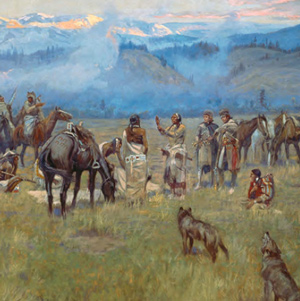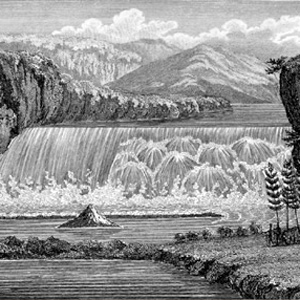Only a skillful photographer with infinite patience, great physical endurance, a crew of dedicated helpers and a superior good luck, could venture far afield. F. Jay Haynes was just such a person.
Frank Jay Haynes (1853-1921) was an important early photographer of Western scenes and people. He shot this photo just a few months before a pioneer settler and entrepreneur named Paris Gibson rode his horse from Fort Benton, forty miles downriver, to see the sight he had read of in a reprint of Nicholas Biddle’s edition (1814) of the Journals of Lewis and Clark. He was inspired by the potential for industrial development of the falls, and envisioned a day when “water power could be shipped across the land by means of electricity.” Two years later Gibson founded the city of Great Falls, Montana, a few miles upstream near Black Eagle Falls, the last of the five cataracts Lewis discovered. Within another decade Great Falls gained the nickname “The Electric City.”
In 1877, while wet-plate photography was still at the height of its development, and stereography (3D photography), which had originated in 1841, was increasing in popularity, Haynes set up a studio at Fargo, in Dakota Territory. Three years later, he and a crew of seven assistants set out on a 1,200-mile picture-taking excursion up the Missouri River, photographing key points along the route, all the way to the falls. Their supplies and equipment, including a light-proof tent for a darkroom, filled two horse-drawn wagons.[1] Untitled typescript page by Jack E. Haynes, son of F. Jay, in Vertical File “Frank Jay Haynes,” Montana Historical Society, Helena. “This trip,” he wrote to his wife, Libby, “is going to be worth a fortune to me for it is going to open up a new field.”[2]Edward W. Nolan, Northern Pacific Views: The Railroad Photography of F. Jay Haynes, 1876-1905 (Helena: Montana Historical Society, 1983), p. 38. In 1881 Haynes became the official photographer for … Continue reading Haynes returned to Fargo late that summer with historic photos of both the “beautiful cascade,” otherwise known as “handsom fall,” and that “sublimely grand object,” the Great Falls of the Missouri. At long last the world could share Meriwether Lewis’s “pleasure and astonishment”—in stereovision!
Pages with Photos by Haynes


The story of Lewis and Clark meeting the Flathead Salish on 4 September 1805 at Ross Hole is told by one expedition member, four Salish Indians, and one western artist.


After Lewis’s preliminary sketch, later artists and photographers contributed to the visual documentation of the “sublimely grand” waterfall including Barralet, Gustavus Sohon, A. E. Mathews, and F. Jay Haynes.
Notes
| ↑1 | Untitled typescript page by Jack E. Haynes, son of F. Jay, in Vertical File “Frank Jay Haynes,” Montana Historical Society, Helena. |
|---|---|
| ↑2 | Edward W. Nolan, Northern Pacific Views: The Railroad Photography of F. Jay Haynes, 1876-1905 (Helena: Montana Historical Society, 1983), p. 38. In 1881 Haynes became the official photographer for the Northern Pacific Railroad, and soon became famous for his popular stereographs of scenes in Yellowstone National Park. In the mid-eighties he switched to George Eastman’s revolutionary new dry-plate process. |

